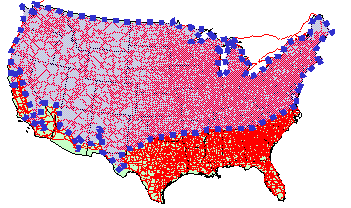Snow and Ice
 Over
70 percent of the nation's roads are located in snowy regions, which
receive more than five inches (or 13 cm) average snowfall annually.
Nearly 70 percent of the U.S. population lives in these snowy regions.
Snow and ice reduce pavement friction and vehicle maneuverability, causing
slower speeds, reduced roadway capacity, and increased crash risk. Average
arterial speeds decline by 30 to 40 percent on snowy or slushy pavement. Freeway
speeds are reduced by 3 to 13 percent in light snow and by
5 to 40 percent in heavy snow. Heavy snow and sleet can also reduce visibility.
Lanes and roads are obstructed by snow accumulation, which reduces capacity
and increases travel time delay.
Over
70 percent of the nation's roads are located in snowy regions, which
receive more than five inches (or 13 cm) average snowfall annually.
Nearly 70 percent of the U.S. population lives in these snowy regions.
Snow and ice reduce pavement friction and vehicle maneuverability, causing
slower speeds, reduced roadway capacity, and increased crash risk. Average
arterial speeds decline by 30 to 40 percent on snowy or slushy pavement. Freeway
speeds are reduced by 3 to 13 percent in light snow and by
5 to 40 percent in heavy snow. Heavy snow and sleet can also reduce visibility.
Lanes and roads are obstructed by snow accumulation, which reduces capacity
and increases travel time delay.
Each year, 24 percent of weather-related vehicle crashes occur on snowy, slushy or icy pavement and 15 percent happen during snowfall or sleet. Over 1,300 people are killed and more than 116,800 people are injured in vehicle crashes on snowy, slushy or icy pavement annually. Every year, nearly 900 people are killed and nearly 76,000 people are injured in vehicle crashes during snowfall or sleet. Snow and ice increase road maintenance costs. Winter road maintenance accounts for roughly 20 percent of state DOT maintenance budgets. State and local agencies spend more than 2.3 billion dollars on snow and ice control operations annually. Each year, these road agencies also spend millions of dollars to repair infrastructure damage caused by snow and ice.
Publications
To view publications related to snow and ice, please select one of the following key words.
- Anti-icing/Deicing
- Anti-icing/Deicing Chemicals
- Avalanche
- Blowing/Drifting Snow
- Ice/Frost
- Snow
- Snow Fence
- Winter Maintenance
- Winter Storm
To view PDF files, you need the Adobe Acrobat Reader.


